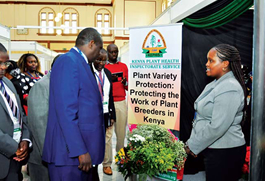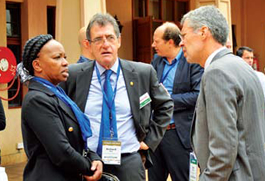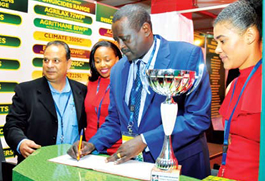For the sixth year in a row, Kenya is set to host the International Flower Trade Expo (IFTEX), slated for June 7-9 at the Oshwal Centre, Parklands, Nairobi.
 Currently, IFTEX is at par with other important flower exhibitions organized by HPP which include World Floral Expo (USA), Agriflor (Quito, Ecuador), and the International Floriculture Trade Fair (Vijfhuizen, Holland), all that are key activities in the flower industry calendar. Since IFTEX opened its doors here in 2012, there has been a steady pattern of target visitors. Kenya’s flowers are a sensation in the US going by the interest the Kenya pavilion attracted during the World Floral Expo in Las Vegas (US) held early this year. This year’s show comes amidst renewed focus in the country following the classification of JKIA to Category A status enabling direct flights to the US from Nairobi. The two make US the main target this year.
Currently, IFTEX is at par with other important flower exhibitions organized by HPP which include World Floral Expo (USA), Agriflor (Quito, Ecuador), and the International Floriculture Trade Fair (Vijfhuizen, Holland), all that are key activities in the flower industry calendar. Since IFTEX opened its doors here in 2012, there has been a steady pattern of target visitors. Kenya’s flowers are a sensation in the US going by the interest the Kenya pavilion attracted during the World Floral Expo in Las Vegas (US) held early this year. This year’s show comes amidst renewed focus in the country following the classification of JKIA to Category A status enabling direct flights to the US from Nairobi. The two make US the main target this year.
It has been costly and lengthy to ship the country’s flowers to the world’s biggest market after the EU. “Owing to the availability of the flights, we expect more American buyers in Nairobi next month going by confirmed visits and increasing inquiries”, says Dick Van Raamsdonk. Nobody can deny the fact that in this year’s show the catchphrase will be, “Buyers from America’’.
The US visitors will be neck to neck with China going by what happened early this year in Guangzhou. The beauty of Kenyan flowers was visible at the recent China Flower Trade Fair in Guangzhou. Visitors came from all corners of the vast continent some purposely looking for the Kenyan pavilion, says Mr. Raamsdonk.
In China, visitors came from all the corners of the vast continent some purposely looking for the Kenya pavilion where a remarkable display resulted in buyers expressing interest to attend the Kenya flower show (IFTEX) to see more varieties and colour. For this reason we also expect more buyers from Asia, the country’s newest and promising market frontier for flowers.
 Industry Focus
Industry Focus
The Kenya Flower Council (KFC) projects that the freight cost for flower exports to the US will halve with direct flights between the two countries. Cargo flights are currently charging Sh400 ($4) per kilogramme of flowers shipped to America via Amsterdam or South Africa. KFC says the charges are high because of the transit stopover.
“It is going to be cheaper for us to export our flowers to the US once direct flights to America start, this will be a big boost to our growers who will see their earnings improve,” said chief executive officer Jane Ngige.
The council is gathering market intelligence on the status of the American market, entry points and investment opportunities. Ms Ngige said the US market would raise competition for Kenyan flowers globally as currently nearly all the produce from the country is sold in Europe.
“Exports to the US implies we will have diversified our markets and we will no longer have to rely on Europe as our major buyer; this will make our produce competitive because of an alternative market,” she said.
She said with the flights, more American buyers are expected in Nairobi during the sixth edition of the International Flower Trade Expo (IFTEX).
Government Support
From farm to market, the Kenya government supports the growers. Our supply chain partnership is an integrated approach to ensure safe and sustainable trade throughout the markets. This was said by Dr. Isaac Macharia, the Phytosanitary Services General Manager at KEPHIS.
“KEPHIS will facilitate the export of flowers to the US, through her regulatory role and ensure shipping requirements for exporting to the United States of America are well understood as the trade between the two countries increases owing to the direct flights”, he said.
Currently, Kenya exports flowers such as roses and summer flowers, and propagation materials (pelargoniums). With the approval, it is expected more players will venture into the market and more produce will be exported in the future.
For the new players, US is just a flower export market like any other. Exports of plants, plant products and regulated articles require phytosanitary certificates issued by the KEPHIS. This is a document that states to the importing country that the produce is free of pests and diseases and meets the importing requirements of the particular country. Plant Import Permits (PIPs) are also required so traders have to know the requirements of the PIP.
This may not be difficult to attain as KEPHIS has a long working relationship with USDA-APHIS (Animal and Plant Health Inspection Service), The NPPO of the USA which ensures the free flow of agricultural trade by overseas markets that meet the importing countries entry requirements.
 Roses and summer flowers are approved by APHIS hence no pest risk analysis is required.
Roses and summer flowers are approved by APHIS hence no pest risk analysis is required.
PRA is the process of evaluating the potential risk of a plant or plant product to introduce pest and disease. It includes establishing the occurrence, introduction potential, establishment potential and economic impact. It establishes whether pest should be regulated, and the strength of any phytosanitary measures to be taken against.
Speaking in the same forum, Mr. Samuel Karongo of Horticultural Crops Directorate said the government was out to support the growers through more international trade fairs that will bring on board growers and buyers from the two countries.
Mr. Karongo said that they will collaborate with all players to ensure capacity building on production and market requirement such as KS1758. The directorate will Partner with development partners in enhancement of market access i.e. working with USAID in the development of the National Traceability System.
“We will strengthen engagement with stakeholders through regular consultative forums, work with research institutions in addressing technical challenges in the sub-sector and comprehensively vet exporters to ensure no few bad eggs spoil the broth”, he added.
Mr. Karongo said the directory will actively participate in the Horticulture Competent Authority Structure (HCAS). This brings together the parent ministry, regulatory bodies and exporter organizations. They will also bring on board other players engaged in the export business such as the consultants and clearing agents. “We will also Collect and disseminate export data to keep our exporters abreast with the market”, he said.
Challenges
Despite the reported impressive growth in the horticulture sub-sector and the significant contribution made by floriculture in this growth, Mr. Karongo acknowledged growers face numerous challenges. He pointed out that, the directorate was engaging relevant government departments to address the high freight charges, emerging pests and diseases, Poor and inadequate post- harvest handling infrastructure, high initial investment costs, fluctuation in exchange rate and high costs of inputs. Well addressed, Kenyan growers will be competitive to the US market which has been colonized by South American growers.
Adding, “Kenyan growers have addressed social issues related to remuneration of workers and safety in their operations and the environmental concerns raised by some NGOs fairly enough”. He also noted that growers have been able to handle the dynamic market standards, frequent changes in products development and competition from other flower producing countries targeting the same market. This makes them competitive to any emerging market.
To consolidate and enhance the growth realized in the sub-sector more needs to be done alongside research on new varieties and technologies (i.e. water efficient and environment friendly), adjust to digital methods of marketing and branding, increase participation in other emerging markets (i.e. far east, Japan and Korea), continuous capacity enhancement in collaboration with growers and other stakeholders, continued advocacy for improved infrastructure in flower producing areas and strengthen regulation of industry players.
Repeat Buyers
Other than the two emerging markets, IFTEX was also consolidating its traditional buyers from Europe and Middle East. “That buyers keep coming year after year is an indication the show meets their expectations and ultimately”, said Mr. Raamsdonk. On the other hand, growers have always put their best mix on show creating a sea of flowers not seen anywhere else under one roof. IFTEX is therefore an international show by any standards and has become a “must do” in the floriculture activity calendar.
Although Kenya actively participates in other international flower shows globally, IFTEX offers the largest number of growers sitting together showcasing the unique characteristics of flowers from the country’s various growing regions. Big heads, small heads, short stems, long stems as well as different varieties coming from the same country complete the picture of market diversity.
Kenya’s position astride the Equator and varying climatic conditions enables the country to grow flowers that compete with those from the other four countries in the world in the same horizon making the nations the top flower producing spots. These are Kenya, Ethiopia, Ecuador and Colombia. Kenya has a mix of low and high lands enabling production of the same variety in different region giving different characteristics for the diverse markets. For instance, the same variety grown in Naivasha, Thika and Nanyuki gives three different shades of the same flower going into different markets, and this is unique to Kenya.
This year, over 5,000 visitors and 225 exhibitors (growers, breeders, consolidators, products and service providers) are expected to participate in the expo, reaffirming the great importance of this annually held international flower trade exhibition. Last year over 1,500 key qualified trade visitors from over 28 countries visited the show, a big number for buyers.
 The show has grown into a top Kenyan brand, strengthening the country’s position as a leader in global markets, while enhancing the image of Nairobi as the home from where 40 per cent of the flowers sold in Europe originate. IFTEX has come at the right time for the Kenya flower industry that is now in the process of market consolidation and retention by positioning its flowers as responsibly grown, and that picture can only be seen at a show of an international magnitude at home.
The show has grown into a top Kenyan brand, strengthening the country’s position as a leader in global markets, while enhancing the image of Nairobi as the home from where 40 per cent of the flowers sold in Europe originate. IFTEX has come at the right time for the Kenya flower industry that is now in the process of market consolidation and retention by positioning its flowers as responsibly grown, and that picture can only be seen at a show of an international magnitude at home.
A Glance at Kenya’s Horticultural sector The horticulture sub-sector has registered a sustained growth of between 10 and 20% over the last 10 years, with a growth rate of 12% realized in 2016 despite many other sectors registering negative growth.
The sub sector therefore contributes immensely to the economic growth of our country. The sub-sector provides direct and indirect employment to over 7 Million Kenyans and contributes to 17% of the GDP. Floriculture contributes between 65-70% of the total horticulture exports i.e in 2014 total exports by value was KShs 84 billion with flowers contributing KShs. 59.89 billion (71.2%). The contribution was 69% and 70% for the years 2015 and 2016 respectively.
Kenya has continued to experienced growth in its share of the global Flower trade in the last decade. Statistics show that Kenya is contributing over 35% of the world flower trade and continues to compete with countries such as Ecuador, Colombia and Ethiopia in the world flower business. In Africa, Kenya is the leading Flower exporter. Indeed in the year 2016, Kenya exported flowers worth Kshs 71 billion representing 70% of the total horticulture exports which stood at (Kshs 101 Billion).


